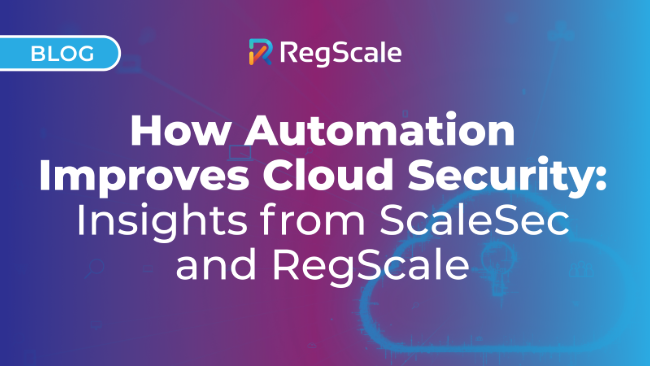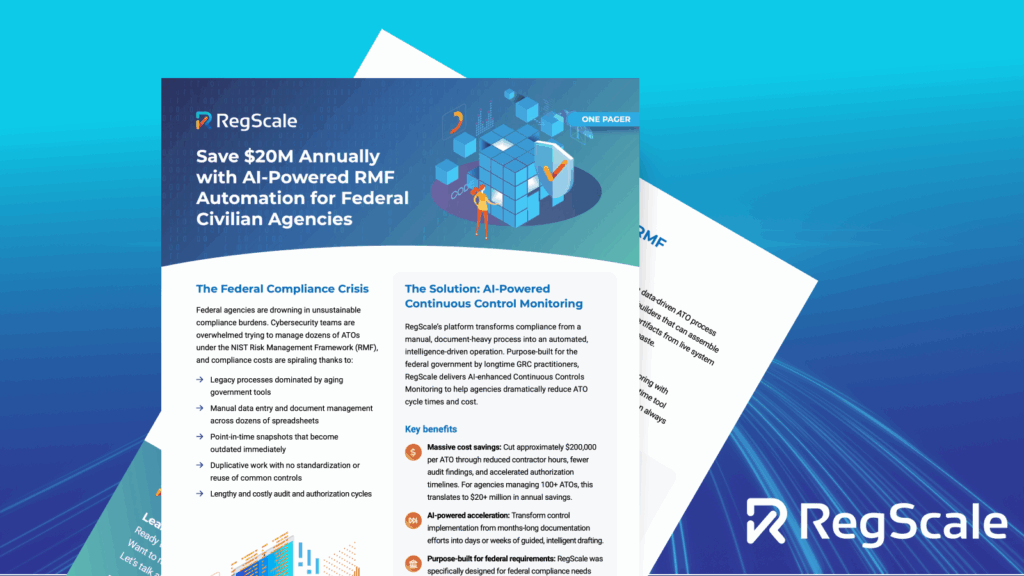How Automation Improves Cloud Security: Insights from ScaleSec and RegScale

As organizations move through their cloud transformation journeys, one truth has become increasingly clear. Automation isn’t just a nice-to-have; it’s essential for maintaining robust cloud security at scale.
The following topics were originally discussed during our Cloud Security Conversation webinar episode, “How Automation Can Improve Cloud Security,” led by our partners at ScaleSec. Read on to discover our top five insights on how automation can fundamentally transform your security posture, improve your compliance management, and supercharge your operational efficiency.
1. Identity Management: The Foundation of Cloud Security
The most critical aspect of cloud security — and the area where we see the most failures — is identity and access management (IAM). The number one recommendation? Get humans out of the process.
Too many organizations continue to allow manual access to production environments, creating enormous security risks. But the truly successful businesses will implement:
- Centrally managed IAM through code repositories and CI/CD processes
- Service account automation that generates identities and distributes permissions granularly
- Principle of least privilege enforced through automated controls
The difference between a really incredible and advanced security posture versus someone who is opening themselves up to enormous risk is literally as simple as how well are you managing your IAM access and how few people are you going to have with access— preferably zero.— John Porter, Principal Cloud Security Consultant at ScaleSec
2. Automation Best Practices: Beyond Identity
Cloud security still relies on some fundamental best practices. You have to be sure you have all the basics, including strong network security controls, encryption, remediation and detection, backups, and more. Luckily, these fundamentals can be automated — not just for deployment, but for ongoing upkeep and maintenance.
Automation helps in several critical ways:
- Get faster and more reliable disaster recovery with infrastructure as code
- Ensure continual compliance with Continuous Controls Monitoring
- Create an always audit-ready state with automated evidence gathering and documentation updates
- Automatically identify when configurations change from approved standards with drift detection
3. Continuous Compliance: Moving Beyond Point-in-Time Audits
Traditional compliance approaches — giving up your weekends and scrambling through reams of paperwork to meet audit dates — are unsustainable and risky. Beyond their operational inefficiency, point-in-time assessments aren’t sufficient for modern compliance frameworks like FedRAMP, which require continuous monitoring (ConMon).
Think of it like housekeeping: you can let everything pile up and then spend days frantically cleaning before your guests arrive … or you can do a bit of continuous upkeep so you’re always ready.
The benefits of this automated, continuous approach to compliance include:
- Audit readiness at all times
- Evidence collection over extended periods
- Proactive issue resolution before things become major problems
- Reduced compliance costs through automation
You really don’t want to have the trash can overflowing and a whole sink piled full of dishes and all your dirty laundry on the floor. What you would rather do is use a dish, wash the dish, and put it away — continuously upkeep your situation — so that you’re existing in a nice environment. The same thing could be said for using automation in the cloud environment.— John Porter, Principal Cloud Security Consultant
4. The Role of AI in Cloud Security
AI is emerging as a powerful tool for GRC teams. Rather than replacing human expertise, AI excels at:
- Removing manual labor from repetitive documentation tasks
- Performing gap analysis to identify potential issues before audits
- Helping to draft and implement control statements
- Offering custom explainers for complex compliance frameworks
That said, AI also has its risks. Organizations need to address “shadow AI” — employees using AI tools without proper governance. Like shadow IT, this often indicates friction in approved processes rather than employee negligence.
AI is the best way to remove toil for people… it’s the difference between a handsaw and a power saw. You still have to have someone who knows what to cut and how to cut, but they don’t have to sit out there for two hours making cuts on boards. You’re enabling more work to be performed faster.— John Porter, Principal Cloud Security Consultant at ScaleSec
5. Machine-to-Machine Communication: Charting the Future with OSCAL
The Open Security Controls Assessment Language (OSCAL) represents the future of compliance automation. Developed by NIST, OSCAL enables machine-to-machine communication for compliance frameworks, allowing:
- Seamless control sharing between different frameworks (ISO, FedRAMP, PCI, etc.)
- Standardized evidence submission to auditors and certification bodies
- Reduced manual translation between compliance requirements
- Future-proofed GRC tool implementations
Final Takeaways for Security Teams
The organizations that thrive in cloud environments are those that embrace automation not as a novelty, but as a fundamental shift in how security and compliance operate. By reducing human friction while maintaining strong security controls, automation can pave the way to the future. Here’s how to make the most of it:
- Embrace the API-first nature of cloud environments through comprehensive automation
- Prioritize IAM by minimizing human access within production systems
- Implement continuous compliance solutions rather than point-in-time audit prep
- Leverage intelligent AI to reduce manual work
- Plan for the future with OSCAL-native tools and processes
Want to learn more about implementing automated cloud security controls? Check out our additional video content with ScaleSec — or reach out directly to discuss how RegScale’s platform can get you started on the path to GRC automation.
Ready to get started?
Choose the path that is right for you!
Skip the line
My organization doesn’t have GRC tools yet and I am ready to start automating my compliance with continuous monitoring pipelines now.
Supercharge
My organization already has legacy compliance software, but I want to automate many of the manual processes that feed it.
